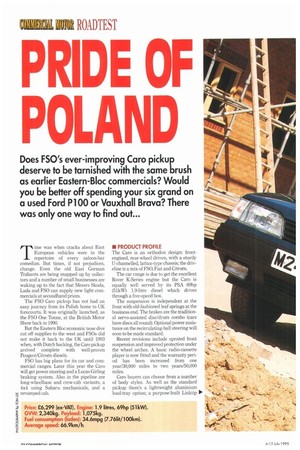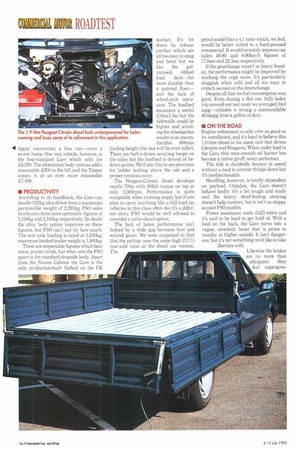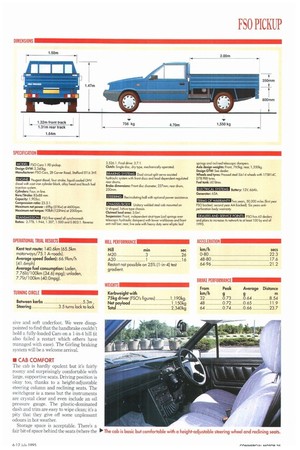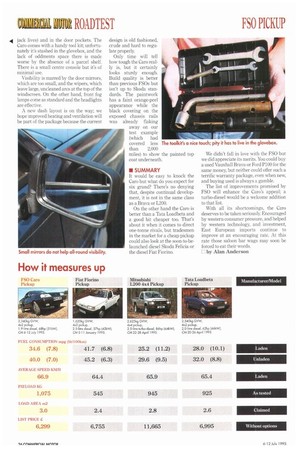PRIDE OF POLAND
Page 24

Page 26

Page 27

Page 28

If you've noticed an error in this article please click here to report it so we can fix it.
Does FSO's ever-improving Caro pickup deserve to be tarnished with the same brush as earlier Eastern-Bloc commercials? Would you be better off spending your six grand on a used Ford P100 or Vauxhall Brava? There was only one way to find out...
Time was when cracks about East European vehicles were in the repertoire of every saloon-bar comedian. But times, if not prejudices, change. Even the old East German Trabants are being snapped up by collectors and a number of small businesses are waking up to the fact that Messrs Skoda, Lath and FSO can supply new light commercials at secondhand prices.
The FSO Caro pickup has not had an easy journey from its Polish home to UK forecourts. It was originally launched, as the FSO One Tonne, at the British Motor Show back in 1990.
But the Eastern Bloc economic nose dive cut off supplies to the west and FSOs did not make it back to the UK until 1993 when, with Dutch backing, the Caro pickup arrived complete with well-proven Peugeot/Citroen diesels.
FSO has big plans for its car and commercial ranges. Later this year the Caro will get power steering and a Lucas Girling braking system. Also in the pipeline are long-wheelbase and crew-cab variants, a 4x4 using Subaru mechanicals, and a revamped cab. • PRODUCT PROFILE The Caro is an orthodox design: frontengined, rear-wheel driven, with a sturdy U-channelled, lattice-type chassis; the driveline is a mix of FSO, Fiat and Citroen.
The car range is due to get the excellent Rover K-Series engine but the Caro is equally well served by its PSA 69hp (51kW) 1.9-litre diesel which drives through a five-speed box.
The suspension is independent at the front with old-fashioned leaf springs at the business end. The brakes are the traditional servo-assisted disc/drum combo (cars have discs all round). Optional power assistance on the recirculating-ball steering will soon to be made standard.
Recent revisions include uprated front suspension and improved protection under the wheel arches. A basic radio-cassette player is now fitted and the warranty period has been increased from one year/30,000 miles to two years/50,000 miles.
Caro buyers can choose from a number of body styles. As well as the standard pickup there's a lightweight aluminium load tray option; a purpose-built Linktip 1111• -44.0 . • .4 tipper conversion; a box van—even a motor home. Our test vehicle, however, is the bog-standard Caro which sells for £6,299. The aluminium body options add a reasonable £200 to the bill and the Tipper comes in at an even more reasonable £7,499.
• PRODUCTIVITY According to its handbook, the Caro can handle 925kg plus driver from a maximum permissible weight of 2,295kg. FSO sales brochures claim more optimistic figures of 1,150kg and 2,340kg respectively. No doubt the alloy body option improves on these figures, but FSO can't say by how much. The rear axle loading is rated at 1,530kg; maximum braked trailer weight is 1,000kg.
These are respectable figures which beat many pricier rivals, but what sets the FSO apart is the standard dropside body. Apart from the Nissan Cabstar the Caro is the only production-built flatbed on the UK market. It's let down by release catches which are all too easy to snag and bend but we like the galvanised, ribbed load deck—far more durable than a painted floor and the lack of wheel-arch intrusion. The loadbed measures a useful 2.0mx1.5m but the sidewalls could be higher and avoiding the wheelarches results in an uncomfortable 800mm loading height (the 4x4 will be even taller). There are half-a-dozen securing hoops on the sides but the loadbed is devoid of tiedown points. We'd also like to see provision for ladder lashing above the cab and a proper tonneau cover.
The Peugeot-Citroen diesel develops nearly 70hp with 90Ibft torque on tap at only 2,000rpm. Performance is quite acceptable when running empty but if you plan to carry anything like a full load (as vehicles in this class often do) it's a different story. FSO would be well advised to consider a turbo-diesel option.
The lack of laden performance isn't helped by a wide gap between first and second gears. We were surprised to find that the pickup uses the same high (3.7:1) rear-axle ratio as the diesel car version. The petrol model has a 4.1 ratio which, we feel, would be better suited to a hard-pressed commercial. It would certainly improve our laden 48-80 and 0-80km/h figures of 17.6sec and 22.3sec respectively.
If the gearchange wasn't so heavy-handed, the performance might be improved by working the cogs more. It's particularly sluggish when cold and all too easy to crunch second on the downchange.
Despite all that its fuel consumption was good. Even during a flat out, fully-laden trip around our test route we averaged 34.6 mpg—unladen it wrung a commendable 40.0mpg from a gallon of derv.
• ON THE ROAD Engine refinement is only ever as good as its installatiok and it's hard to believe this 1.9-litre diesel is the same unit that drives Citroens and Peugeots. When under load in the Caro, this once-smooth oil burner has become a rather gruff, noisy performer.
The ride is decidedly bouncy at speed without a load to simmer things down but it's unobjectionable.
Handling, however, is totally dependent on payload. Unladen, the Caro doesn't behave badly: it's a bit rough and ready and the heavy, dead-feeling steering doesn't help matters, but it isn't as sloppy as past FSO models.
Power assistance costs £425 extra and it's said to be hard to get hold of. With a load on the back, the Caro turns into a vague, unwieldy beast that is prone to wander at higher speeds. It isn't dangerous, but it's not something we'd like to take liberties with. Likewise the brakes are no more than adequate: they feel unprogres sive and soft underfoot. We were disappointed to find that the handbrake couldn't hold a fully-loaded Caro on a 1-in-4 hill (it also failed a restart which others have managed with ease). The Girling braking system will be a welcome arrival.
• CAB COMFORT The cab is hardly opulent but it's fairly roomy and surprisingly comfortable with large, supportive seats. Driving position is okay too, thanks to a height-adjustable steering column and reclining seats. The switchgear is a mess but the instruments are crystal clear and even include an oil pressure gauge. The plastic-dominated dash and trim are easy to wipe clean; it's a pity that they give off some unpleasant odours in hot weather.
Storage space is acceptable. There's a fair bit of space behind the seats (where the ■ The cab is basic but comfortable with a height-adjustable steering wheel and reclining seats. 4 jack lives) and in the door pockets. The Caro comes with a handy tool kit; unfortunately it's stashed in the glovebox, and the lack of oddments space there is made worse by the absence of a parcel shelf. There is a small centre console but it's of minimal use.
Visibility is marred by the door mirrors, which are too small, and the wipers, which leave large, uncleaned arcs at the top of the windscreen. On the other hand, front fog lamps come as standard and the headlights are effective.
A new dash layout is on the way; we hope improved heating and ventilation will be part of the package because the current design is old fashioned, crude and hard to regulate properly.
Only time will tell how tough the Caro really is, but it certainly looks sturdy enough. Build quality is better than previous FSOs but isn't up to Skoda standards. The paintwork has a faint orange-peel appearance while the black covering on the exposed chassis rails was already flaking away on our test example (which had covered less than 2,000 miles) to show the painted top coat underneath.
10 SUMMARY
It would be easy to knock the Caro but what do you expect for six grand? There's no denying that, despite continual development, it is not in the same class as a Brava or L200.
On the other hand the Caro is better than a Tata Loadbeta and a good bit cheaper too. That's about it when it comes to direct one-tonne rivals, but tradesmen in the market for a cheap pickup could also look at the soon-to-belaunched diesel Skoda Felicia or the diesel Fiat Fiorino. We didn't fall in love with the FS° but we did appreciate its merits. You could buy a used Vauxhall Brava or Ford P100 for the same money, but neither could offer such a terrific warranty package, even when new, and buying used is always a gamble.
The list of improvements promised by FS0 will enhance the Caro's appeal; a turbo-diesel would be a welcome addition to that list.
With all its shortcomings, the Caro deserves to be taken seriously. Encouraged by western consumer pressure, and helped by western technology, and investment, East European imports continue to improve at an encouraging rate. At this rate those saloon bar wags may soon be forced to eat their words.
ET by Alan Anderson




































































































